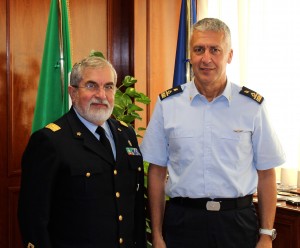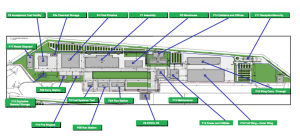2013-11-01 By Robbin Laird
During my trip to Italy in October 2013, I was able to spend two days at the Cameri F-35 facilities and to then discuss my visit with two senior Italian Air Force officials, intimately familiar with the program and the Cameri effort.
I sat down with Lt. General Domenico Esposito and Brigadier General Giuseppe Lupoli to discuss the Cameri effort.
Lt. General Esposito is the head of Air Armaments procurement and has an extensive background in logistics, which is really central when discussing Cameri. BG Lupoli is the head of fixed wing aircraft procurement issues within Esposito’s directorate. In this capacity, he also functions as the Italian MOD’s FACO program manager.

Lt. General Esposito kindly signed a book after the interview, which is entitled, Defence Procurement: The Italian Way.
It was clear both after the two day Cameri visit and the discussions with the two generals that the F-35 procurement way for Italy is quite visionary: the focus is upon establishing an Italian located European support facility for the F-35 global enterprise.
The Cameri Air Base is a logistics facility where Eurofighters and Tornados are currently maintained.
The Italian government under the management of Alenia Aermacchi (AAeM) has built a 22 building facility to support the F-35 program.

The support comes in three parts.
First, there is a Final Check Out and Assembly facility, for assembling Italy’s As and Bs, as well as other European F-35 partners, initially the Netherlands.
Second, there is a wing construction facility with Italy building a minimum of 835 full wings for the F-35 global program.
Third, with the 22 buildings of more than a million square feet of covered work space comes significant space to build out support for F-35s operated by the US and allies in Europe. With the Mediterranean and the Middle East as a busy operational area, the Cameri facility can provide significant operational support to the F-35 fleet operating in the area.
Lt. General Esposito underscored that the establishment of the FACO has been a challenge.
And it has been difficult as well to get other Europeans to understand fully what is behind the Italian approach: it is not just about assembling Italian planes but it is about taking a new look at the European approach to shared support.
We certainly hope other European nations, besides the Dutch, will look to the FACO to assemble their planes. For this facility is much closer to them physically than is Fort Worth.
Esposito highlighted that the Italian way with F-35 was to build a facility not simply targeted on Italian needs.
Cameri is in Italy but it is a well located facility open to significant European participation and to support to the European and American operational fleets in Europe. We have seen Cameri as part of a global solution, and not just a narrowly understood Italian focus.
BG Lupoli added that he believed that there might be facilities built to support manufacturing in the Far East as well.
This would mean that there would then be at least three centers of excellence in support of the F-35 global fleet, rather than having just one located in the United States.
We look at Cameri as a key facility in such a global enterprise and able to support the F-35 fleet operating in the region without having to look at the flag on the plane.
In effect, the two generals argued that Cameri should be looked at as an Italian-based facility for the F-35 global enterprise.
And as such would be part of the next thirty years of innovation associated with the F-35 program.
The two generals added three other points of note as well.
First, Cameri is well located within Europe to operate as a sustainment facility. It is located close to Milan and its commercial airports. And there are significant port facilities as well.
Second, Cameri has been the aviation business for a long time and there are many smaller companies in the region, which could support a build out of the sustainment facility over time as well.
Third, Cameri can be a key warehousing facility for the F-35. The support facilities are completely compliant with NATO and American safety and security standards. For example, the USAF could operate within Cameri as a sustainment facility quite easily as the security standards for doing so are ALREADY in place.
And it is the only European base where a testing facility for stealth and ability to paint aircraft are both present.
It should be remembered that because the F-35 is built with common parts identifiers for every plane built, nations will already have commonality in parts identification built in.
And with a common IT system, the ability to identify those parts and move them within multinational fleets is historically unprecedented for military aircraft.
In other words, the Italians have recognized the global fleet reality of the F-35 and have built in its anticipation.
This certainly highlights the commitment of Italy to 21st century innovation.
The photos below show workers at the FACO working on the first jet.
The workforce is a mix of older and younger workers, and provides a significant boost to the future of Italian aerospace and defense.
[slidepress gallery=’cameri-and-the-f-35′]
Credit Photos: Alenia Aermacchi (AAeM)
According to Finmeccanica CEO Alessandro Pansa, in a recent comment during an audit at the Chamber of Deputies Defense Commission:
With the participation in the F-35 program “the Italian industrial system brings home potential returns for $ 10 billion” and occupational returns will exceed 5,000 units.”
The development of these potentialities “depends on our capability to use the infrastructure which have been created to build components and to provide maintenance related to avionics and electronics both for the European aircraft and the US aircraft based in Europe.
There’s no other European plant with the same requisites as our plant in Cameri”
Pansa underscored that 90 Italian companies are involved in the program and so far contracts have been subscribed for $765 million.
For additional stories on the Italians and the F-35 see the following:
https://www.sldinfo.com/re-thinking-the-role-of-the-smaller-deck-carrier-the-case-of-cavour/
https://www.sldinfo.com/cameri-and-the-f-35-building-out-a-new-manufacturing-facility/
https://www.sldinfo.com/an-update-from-cameri-on-the-cameri-f-35-campus-october-2013/
https://www.sldinfo.com/building-out-an-f-35-fleet-sustainment-center-in-italy/
https://www.sldinfo.com/visiting-the-italian-air-ministry/

